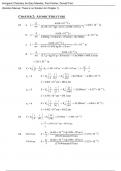Examen
Inorganic Chemistry 5th Edition By Gary Miessler, Paul Fischer, Donald Tarr (Solution Manual)
- Cours
- Établissement
Inorganic Chemistry 5e Gary Miessler, Paul Fischer, Donald Tarr (Solution Manual) Inorganic Chemistry 5e Gary Miessler, Paul Fischer, Donald Tarr (Solution Manual)
[Montrer plus]



